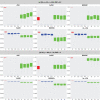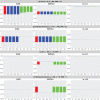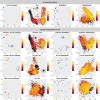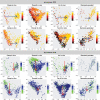Two-stage linked component analysis for joint decomposition of multiple biologically related data sets
- PMID: 35358296
- PMCID: PMC9566367
- DOI: 10.1093/biostatistics/kxac005
Two-stage linked component analysis for joint decomposition of multiple biologically related data sets
Abstract
Integrative analysis of multiple data sets has the potential of fully leveraging the vast amount of high throughput biological data being generated. In particular such analysis will be powerful in making inference from publicly available collections of genetic, transcriptomic and epigenetic data sets which are designed to study shared biological processes, but which vary in their target measurements, biological variation, unwanted noise, and batch variation. Thus, methods that enable the joint analysis of multiple data sets are needed to gain insights into shared biological processes that would otherwise be hidden by unwanted intra-data set variation. Here, we propose a method called two-stage linked component analysis (2s-LCA) to jointly decompose multiple biologically related experimental data sets with biological and technological relationships that can be structured into the decomposition. The consistency of the proposed method is established and its empirical performance is evaluated via simulation studies. We apply 2s-LCA to jointly analyze four data sets focused on human brain development and identify meaningful patterns of gene expression in human neurogenesis that have shared structure across these data sets.
Keywords: Integrative methods; Joint decomposition; Low rank models; Multiview data; Principal component analysis.
© The Author 2022. Published by Oxford University Press. All rights reserved. For permissions, please e-mail: journals.permissions@oup.com.
Figures





References
-
- Bickel, P. J. and Levina, E. (2008). Regularized estimation of large covariance matrices. The Annals of Statistics 36, 199–227.
-
- BrainSpan, BrainSpan. (2011). Atlas of the developing human brain. Secondary BrainSpan: Atlas of the Developing Human Brain.
-
- Bunea, F. and Xiao, L. (2015). On the sample covariance matrix estimator of reduced effective rank population matrices, with applications to fPCA. Bernoulli 21, 1200–1230.
Publication types
MeSH terms
Grants and funding
LinkOut - more resources
Full Text Sources
Research Materials

